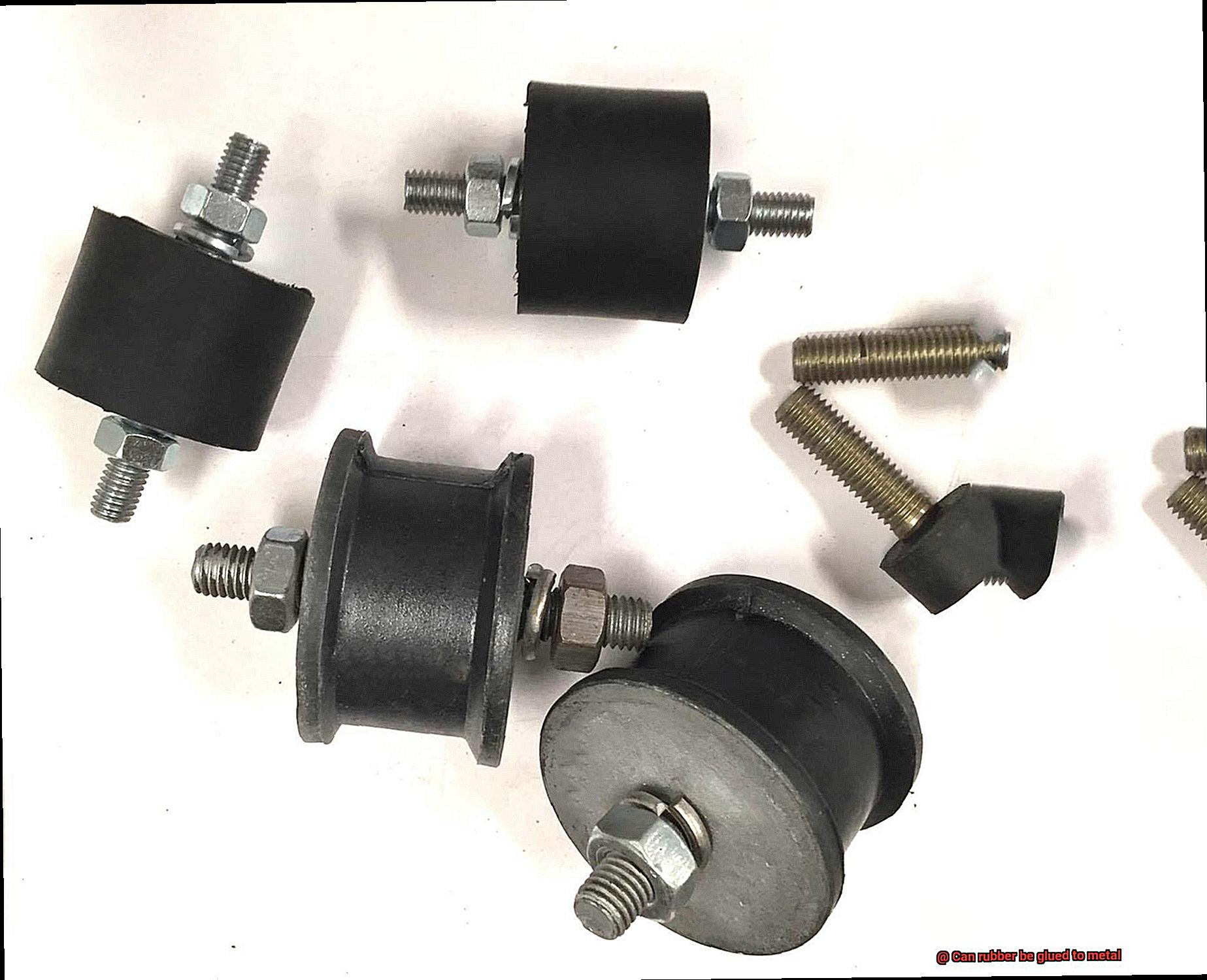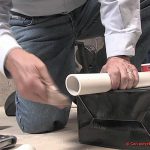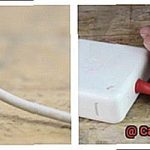Ready to dive into a world where steel and rubber collide, defying the laws of physics? Get ready for an extraordinary journey through the captivating realm of adhesive chemistry. Imagine the fusion of solid metal and flexible rubber, challenging boundaries and sparking your imagination. Today, we unravel the enigma that has puzzled many for ages: Can rubber be glued to metal?
Intrigued? Prepare to be enchanted as we explore the possibilities, debunk myths, and uncover the secrets of this mesmerizing combination. Whether you’re a DIY enthusiast seeking to revive your trusty metal tool handles or an adventurous soul yearning to create innovative rubber-metal hybrids, this guide holds the key to unlocking your desired achievements.
Let’s begin by unveiling the undisputed champion of adhesives – not your ordinary glue from a craft store shelf. No, we’re diving into the world of industrial-strength adhesives capable of defying gravity, withstanding extreme temperatures, and standing the test of time.
Why is it crucial to understand the intricate bond between rubber and metal? Well, my curious companions, envision improved product design, heightened efficiency, and enhanced safety. Think robust machinery, reliable automotive parts, and resilient footwear – all made possible by the magical harmony found in the rubber-metal alliance.
So fasten your seatbelts as we embark on a captivating quest. Join us as we explore the chemistry behind gluing rubber to metal, along with techniques and best practices. Brace yourself for a revelation that will leave you eager to experiment and uncover the limitless potential this bond has to offer. Stay tuned for upcoming chapters where we unravel the secrets behind this extraordinary union – one that defies expectations, revolutionizes industries, and expands our horizons of what is truly possible.
Adhesive Types: Epoxy, Cyanoacrylate (Super Glue), and Specialized Rubber-to-Metal Bonding Adhesives
Contents
- 1 Adhesive Types: Epoxy, Cyanoacrylate (Super Glue), and Specialized Rubber-to-Metal Bonding Adhesives
- 2 Factors to Consider When Gluing Rubber to Metal
- 3 Surface Preparation for Optimal Bonding Strength
- 4 The Role of Temperature in Bonding Rubber to Metal
- 5 Chemical Exposure and Moisture Resistance
- 6 Different Stress Levels for Different Applications
- 7 Benefits of Using Specialized Adhesives for Bonding Rubber to Metal
- 8 Conclusion
Have you ever marveled at the ability of rubber to cling to metal surfaces? It’s not magic, but rather the result of using the right adhesive. Adhesives have the power to create strong bonds between rubber and metal, and in this article, we will delve into the advantages and considerations of three adhesive types: epoxy, cyanoacrylate (super glue), and specialized rubber-to-metal bonding adhesives.
Epoxy: Unyielding Strength and Resilience
When it comes to bonding rubber to metal, epoxy stands as a symbol of strength and resilience. This adhesive is renowned for its exceptional bonding capabilities.
Comprising two components – a resin and a hardener – epoxy forms a chemical bond that can withstand extreme temperatures while offering resistance against chemicals and moisture.
Whether you’re sealing automotive parts or affixing rubber gaskets in machinery, epoxy is the adhesive superhero you need by your side.
Cyanoacrylate: Instant Fixation, Rapid Results
For those quick repairs or small-scale projects, cyanoacrylate, also known as super glue, takes center stage as the adhesive magician. With its lightning-fast curing time, super glue provides instant bonding that seems almost magical.
Perfect for adhering small pieces of rubber to metal surfaces, it works wonders in a pinch. However, bear in mind that in certain applications where long-term durability is essential, super glue may not be as reliable as epoxy. So while it excels at quick fixes, consider other options for more lasting bonds.
Specialized Rubber-to-Metal Bonding Adhesives: The Perfect Union
Imagine an adhesive specifically designed to forge a harmonious union between rubber and metal – that’s precisely what specialized rubber-to-metal bonding adhesives achieve.
These adhesives are formulated to optimize the bond between rubber and metal surfaces. They bravely withstand harsh conditions, from high temperatures to relentless vibrations.
With their enhanced flexibility and elasticity, they ensure a bond that endures the test of time. Whether it’s automotive weatherstripping or sealing gaskets, these adhesives play matchmaker for rubber and metal.
Considerations: The Key to Unlocking Success
Selecting the right adhesive is pivotal for successful rubber-to-metal bonding. Take into account factors such as temperature resistance, chemical resistance, flexibility, and bonding strength.
Each adhesive type offers its own unique advantages and considerations, so choose the one best suited to your specific application needs.
Additionally, proper surface preparation is the secret to achieving a formidable bond. A clean, dry, and contaminant-free surface will maximize adhesion and guarantee a bond that stands strong.
Conclusion:
Adhesives possess an incredible ability to bring rubber and metal together in perfect harmony. Epoxy showcases unparalleled strength and durability, while super glue dazzles with its swift action.
Factors to Consider When Gluing Rubber to Metal
As an expert in the field, I’m here to guide you through the key factors to consider for a successful bond. Get ready to dive into the fascinating world of rubber-to-metal bonding.
Surface Preparation:
Like a blank canvas for an artist, proper surface preparation is vital. Ensure both surfaces are pristine – clean, dry, and free from dirt, dust, grease, or oil. These contaminants can thwart the adhesive’s magic, so don’t underestimate the power of cleanliness.
Type of Rubber:
Rubbers come in various types, each with its unique compatibility with adhesives. Don’t overlook this crucial factor – consider the specific rubber you’re working with. Whether it’s natural rubber, neoprene, silicone, or EPDM, choose an adhesive formulation that complements your rubber compound.
Type of Metal:
Metals also play a significant role in adhesive bonding. Steel, aluminum, stainless steel – they all have distinct surface properties that impact the bond strength. To ensure success, select an adhesive that harmonizes with the specific metal substrate in question.
Adhesive Selection:
The right adhesive can make or break your rubber-to-metal bond. With a plethora of options like cyanoacrylate (super glue), epoxy, contact cement, and polyurethane adhesives, you have a world of possibilities at your fingertips. But choose wisely. Factors like bond strength, flexibility, temperature resistance, and curing time should guide your selection process.
Flexibility and Movement:
Rubber materials are known for their elasticity and propensity for flexing and movement. To withstand these demands without compromising integrity, opt for flexible adhesives like silicone or polyurethane-based options. Embrace the power of flexibility for a lasting bond.
Temperature Resistance:
Environmental factors can make or break your rubber-to-metal bond. Consider the temperature range your assembly may encounter. Select an adhesive that can brave extreme temperatures without losing its bond strength. High-temperature formulations or adhesives designed for low-temperature environments are your go-to options.
Surface Preparation for Optimal Bonding Strength
Today, we embark on a thrilling exploration of the vital topic: surface preparation for achieving optimal bonding strength. Brace yourselves as we unravel the secrets to forging unbreakable bonds.
Cleanliness reigns supreme in the realm of successful bonding. Picture trying to stick two pieces of gum together with crumbs and dirt in between – a disastrous endeavor. To lay the foundation for a formidable bond, pristine surfaces are non-negotiable. Arm yourself with a mild detergent or solvent compatible with both rubber and metal, and scrub away any dirt, dust, oil, or contaminants until those surfaces gleam.
Now that cleanliness is ensured, let’s roughen things up a bit. Rubber and metal surfaces tend to be slick, making it challenging for adhesives to grip tightly. Fear not. By introducing texture to the surfaces, we provide adhesives with ample contact points for a robust bond.
Sanding, grinding, or employing specific abrasive materials are your allies in this endeavor. Proceed with caution, as the extent of roughening required varies based on adhesive and materials involved.
Dryness becomes the virtue that seals the deal. Moisture acts as an unwelcome third wheel in this bonding relationship – an interference that weakens bonds over time. After your diligent cleaning and roughening efforts, grant those surfaces ample time to dry completely before proceeding.
Air drying or employing trusty cloth or paper towels are your tools of choice. Exercise patience, dear friends.
Certain rubber materials demand extra attention for a strong connection to metal. Enter the superheroes of surface treatment: primers and adhesion promoters. These remarkable products enhance the adhesion properties of rubber and metal surfaces, forging an even mightier bond. Adhere to the manufacturer’s instructions diligently to unleash their full potential.
Last but certainly not least, the choice of adhesive determines the success of your bonding journey. From rubber-based adhesives to epoxy, cyanoacrylate, and polyurethane adhesives, a plethora of options awaits.
Each adhesive possesses unique strengths and weaknesses, so select one that aligns with your specific application requirements. Compatibility with rubber and metal, sufficient bond strength, and resistance to environmental factors are your criteria for the perfect adhesive match.
The Role of Temperature in Bonding Rubber to Metal
Prepare to be amazed as we delve into the scorching world of temperature and its pivotal role in forging unbreakable connections between rubber and metal. So, don your lab coats and join us on this exhilarating journey as we unravel the mysteries of this fiery bonding adventure.
The Dance of Expansion and Contraction:
As the temperature rises, these materials start to shimmy and sway, expanding at different rates. This rhythmic performance, however, can introduce stress to the bond, potentially weakening or even causing it to fail. Similarly, as temperatures drop, both rubber and metal contract, creating tension that strains the bond.
Choosing the Right Adhesive:
To ensure an unwavering connection, selecting an adhesive that can withstand temperature fluctuations is paramount. Luckily, some adhesives are specially crafted to brave the heat or chill without compromising their gripping strength. Whether you opt for rubber-based adhesives, epoxy wonders, or polyurethane powerhouses, make sure they are primed for temperature challenges.
Curing Under Control:
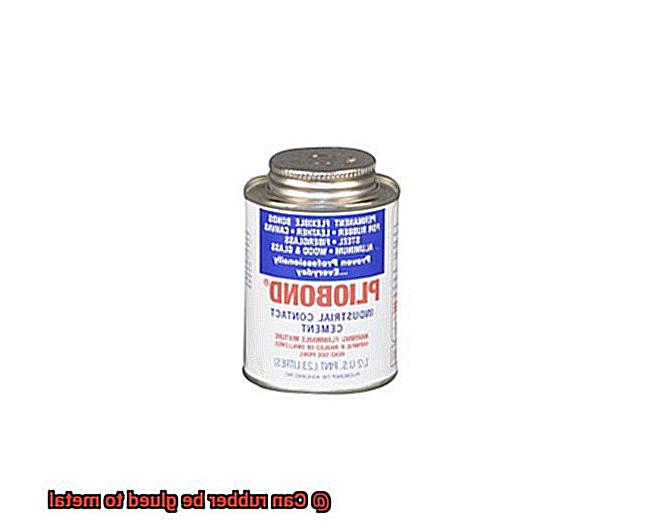
Now let’s delve into the captivating process of curing – the moment when the bond solidifies. Temperature also plays a crucial role here. Certain adhesives necessitate specific curing temperatures to achieve optimal bonding performance. Hence, it is vital to meticulously follow instructions and create the perfect environment for your adhesive to work its magic.
Surface Preparation: The First Step in Bonding Bliss:
Irrespective of the temperature conditions, proper surface preparation remains paramount for a robust bond. Remember our previous section? Cleanliness is key. Scrub those surfaces until they gleam, eliminating any lingering crumbs or dirt that could hinder bonding.
But don’t stop there – roughen things up. Sand, grind, or employ abrasive materials to create textured surfaces that ensure a tenacious grip. And don’t forget to allow those surfaces to dry completely before proceeding.
Chemical Exposure and Moisture Resistance
Get ready for another exhilarating adventure into the world of rubber-to-metal bonding. In our last journey, we uncovered the fiery dance between temperature and adhesives.
Today, we’re diving deeper into the secrets of chemical exposure and moisture resistance. So grab your lab coats because we’re about to embark on another thrilling bonding expedition.
Chemical Compatibility: The Key to Success
Just like in any relationship, compatibility is crucial. When bonding rubber to metal, chemical compatibility ensures a strong and long-lasting bond. Rubber materials are sensitive souls that can degrade when exposed to certain chemicals. Oils, solvents, and acids have the power to make rubber swell, soften, or even dissolve, weakening or breaking the adhesive bond. To conquer this challenge, choose an adhesive resistant to the specific chemicals your rubber might encounter in its intended application.
Moisture: The Sneaky Saboteur
If you thought chemicals were the only adversaries on this bonding journey, think again. Moisture can be a sneaky saboteur that weakens bonds and causes headaches for rubber-to-metal connections.
Corrosion of the metal surface due to moisture significantly compromises bond strength. Additionally, moisture can cause rubber materials to swell or deteriorate over time – not what we want in our adhesive adventures. To defeat this villainous moisture, select an adhesive with excellent moisture resistance properties.
Adhesive Options: Finding Your Perfect Match
Now that we understand the importance of chemical exposure and moisture resistance, let’s explore some adhesive options that meet all the requirements for a successful rubber-to-metal bond.
Cyanoacrylate Adhesives – The Quick and Strong Performers:
Cyanoacrylate-based adhesives, also known as super glue, are sprinters in the bonding world. They provide quick and robust bonds between rubber and metal surfaces. Resistant to many chemicals and offering good moisture resistance, cyanoacrylate adhesives deliver impressive performance. However, be cautious with high-temperature applications as they may not be suitable for such conditions.
Different Stress Levels for Different Applications
Today, we unravel one of the most critical secrets to achieving a strong and enduring bond – understanding how different stress levels demand different adhesive solutions. Brace yourselves as we navigate the treacherous waters of stress and discover the adhesive options that can conquer any challenge.
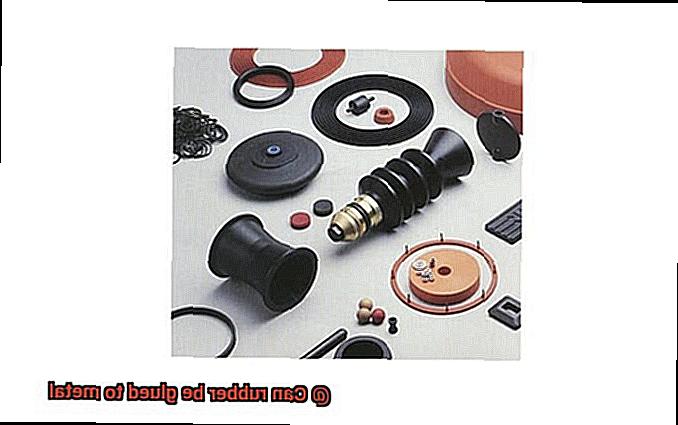
Low-Stress Applications: Where Flexibility Reigns Supreme
Imagine a world of sealing and vibration dampening, where stress levels tiptoe on the lower end of the spectrum. Here, flexibility becomes our guiding light. Behold the silicone-based adhesives, masters of adaptability.
With their exceptional temperature resistance and unrivaled adhesion properties, these heroes form bonds that can withstand moderate stress levels. Whether it’s sealing a rubber gasket or taming vibrations in cutting-edge electronics, silicone-based adhesives ensure a reliable connection.
High-Stress Applications: Unleashing the Power of Strength
Now, let us venture into the realm where heavy loads and mighty impact forces reign supreme. In these domains of extreme stress, our adhesive must rise above ordinary strength. Enter the indomitable epoxy adhesives – the warriors of rubber-to-metal bonding. These formidable champions forge unyielding bonds that defy deformation. From automotive marvels exposed to relentless mechanical stress to colossal machinery components, epoxy adhesives stand tall against overwhelming force.
Surface Preparation: The Hidden Arsenal

In our quest for an unbreakable bond between rubber and metal, we must not overlook the importance of proper surface preparation – our secret weapon. Before the epic clash between adhesive and substrate commences, both surfaces must undergo thorough cleansing and degreasing.
This sacred ritual ensures optimal adhesion by banishing all contaminants and barriers that dare challenge our bond’s might. But wait, there’s more. By roughening the surfaces through the art of sanding or employing abrasive materials, we unlock untapped power. This technique increases the available surface area, fortifying the connection between rubber and metal.
Benefits of Using Specialized Adhesives for Bonding Rubber to Metal
Welcome back, fellow adventurers, as we embark on a thrilling exploration into the wonders of specialized adhesives for bonding rubber to metal. In our previous expedition, we uncovered the secrets to creating a strong and enduring bond.
Now, let’s dive into the extraordinary benefits that these adhesives bring to this unique union.

Incredible Adhesion Strength:
Specialized adhesives are the true superheroes of rubber-to-metal bonding. With their unique properties, they ensure an unyielding and durable bond between these seemingly incompatible materials. No matter the application, whether it’s in vehicles or industrial machinery, these adhesives provide exceptional adhesion strength that can withstand high stress and heavy loads. It’s like having a mighty fortress keeping everything firmly intact.
Flexibility at Its Finest:
Imagine a world of changing temperatures, constant movements, and mechanical chaos. In such dynamic environments, the flexibility of specialized adhesives shines through. These remarkable adhesives allow the bonded rubber and metal to expand and contract independently without compromising the bond. Whether faced with varying rates of expansion or contraction, they hold tight, preventing any separation or detachment. They truly adapt to any situation.
Resisting Environmental Extremes:
Nature can be a formidable opponent, especially for rubber-to-metal bonds exposed to harsh conditions. Fear not. Specialized adhesives come to the rescue with their resistance to chemicals, moisture, UV radiation, extreme temperatures, and other environmental factors. Be it scorching heat or freezing cold, these adhesives won’t back down and will keep your bond rock-solid against even the harshest elements.
Aging Like Fine Wine:
Time may pass, but specialized adhesives remain steadfast. They resist aging and degradation over time, ensuring that the bond between rubber and metal endures. Even after prolonged use, these adhesives maintain their strength and integrity, providing unparalleled reliability for manufacturers and users alike. You can trust that your bonded assembly will stand the test of time with these exceptional adhesives.
jq8L9nP718g” >
Conclusion
In conclusion, the answer to the question “Can rubber be glued to metal?” is a resounding yes. With the right adhesive and proper preparation, rubber can indeed be securely bonded to metal surfaces. The key lies in choosing a high-quality adhesive specifically designed for bonding rubber and metal together.
Whether you’re working on a DIY project or tackling a professional repair job, it’s essential to select an adhesive that offers excellent adhesion and durability. Look for adhesives that are specifically formulated for rubber-to-metal bonding, as they will provide the best results. These adhesives often contain special ingredients that promote strong chemical bonds between the rubber and metal surfaces.
Before applying the adhesive, make sure to thoroughly clean and dry both the rubber and metal surfaces. Any dirt, grease, or moisture can interfere with the bonding process and weaken the overall bond strength. Use a mild detergent or solvent to remove any contaminants from both surfaces, then allow them to dry completely before proceeding with the gluing process.
Once your surfaces are clean and dry, apply a thin layer of adhesive onto both the rubber and metal surfaces. It’s important to follow the manufacturer’s instructions regarding application techniques and curing times. Some adhesives may require you to apply multiple coats or use additional primers for optimal bonding results.
After applying the adhesive, carefully press the rubber onto the metal surface, ensuring even contact across the entire area. Apply firm pressure for a few minutes to ensure proper adhesion. If necessary, use clamps or other methods to hold the two materials together while they bond.
Allow sufficient time for the adhesive to cure fully before subjecting your bonded rubber-to-metal assembly to any stress or load-bearing activities. This curing time can vary depending on factors such as temperature and humidity levels but typically ranges from several hours to 24 hours.
In summary, by selecting an appropriate adhesive, properly preparing both surfaces, and following recommended application techniques, you can successfully glue rubber to metal.
This opens up a world of possibilities for various projects, repairs, and applications where the combination of these two materials is required.

